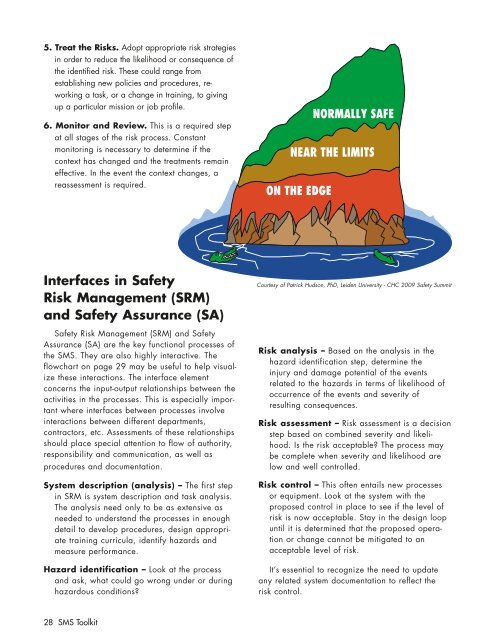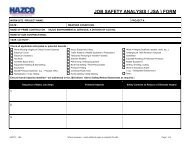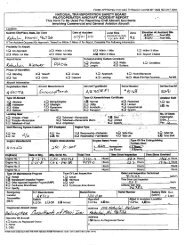International Helicopter Safety Team Safety Management System Toolkit
IHST - Safety Management Toolkit - Skybrary
IHST - Safety Management Toolkit - Skybrary
- No tags were found...
You also want an ePaper? Increase the reach of your titles
YUMPU automatically turns print PDFs into web optimized ePapers that Google loves.
5. Treat the Risks. Adopt appropriate risk strategies<br />
in order to reduce the likelihood or consequence of<br />
the identified risk. These could range from<br />
establishing new policies and procedures, reworking<br />
a task, or a change in training, to giving<br />
up a particular mission or job profile.<br />
6. Monitor and Review. This is a required step<br />
at all stages of the risk process. Constant<br />
monitoring is necessary to determine if the<br />
context has changed and the treatments remain<br />
effective. In the event the context changes, a<br />
reassessment is required.<br />
NORMALLY SAFE<br />
NEAR THE LIMITS<br />
ON THE EDGE<br />
Interfaces in <strong>Safety</strong><br />
Risk <strong>Management</strong> (SRM)<br />
and <strong>Safety</strong> Assurance (SA)<br />
<strong>Safety</strong> Risk <strong>Management</strong> (SRM) and <strong>Safety</strong><br />
Assurance (SA) are the key functional processes of<br />
the SMS. They are also highly interactive. The<br />
flowchart on page 29 may be useful to help visualize<br />
these interactions. The interface element<br />
concerns the input-output relationships between the<br />
activities in the processes. This is especially important<br />
where interfaces between processes involve<br />
interactions between different departments,<br />
contractors, etc. Assessments of these relationships<br />
should place special attention to flow of authority,<br />
responsibility and communication, as well as<br />
procedures and documentation.<br />
<strong>System</strong> description (analysis) – The first step<br />
in SRM is system description and task analysis.<br />
The analysis need only to be as extensive as<br />
needed to understand the processes in enough<br />
detail to develop procedures, design appropriate<br />
training curricula, identify hazards and<br />
measure performance.<br />
Hazard identification – Look at the process<br />
and ask, what could go wrong under or during<br />
hazardous conditions?<br />
Courtesy of Patrick Hudson, PhD, Leiden University - CHC 2009 <strong>Safety</strong> Summit<br />
Risk analysis – Based on the analysis in the<br />
hazard identification step, determine the<br />
injury and damage potential of the events<br />
related to the hazards in terms of likelihood of<br />
occurrence of the events and severity of<br />
resulting consequences.<br />
Risk assessment – Risk assessment is a decision<br />
step based on combined severity and likelihood.<br />
Is the risk acceptable? The process may<br />
be complete when severity and likelihood are<br />
low and well controlled.<br />
Risk control – This often entails new processes<br />
or equipment. Look at the system with the<br />
proposed control in place to see if the level of<br />
risk is now acceptable. Stay in the design loop<br />
until it is determined that the proposed operation<br />
or change cannot be mitigated to an<br />
acceptable level of risk.<br />
It’s essential to recognize the need to update<br />
any related system documentation to reflect the<br />
risk control.<br />
28 SMS <strong>Toolkit</strong>







